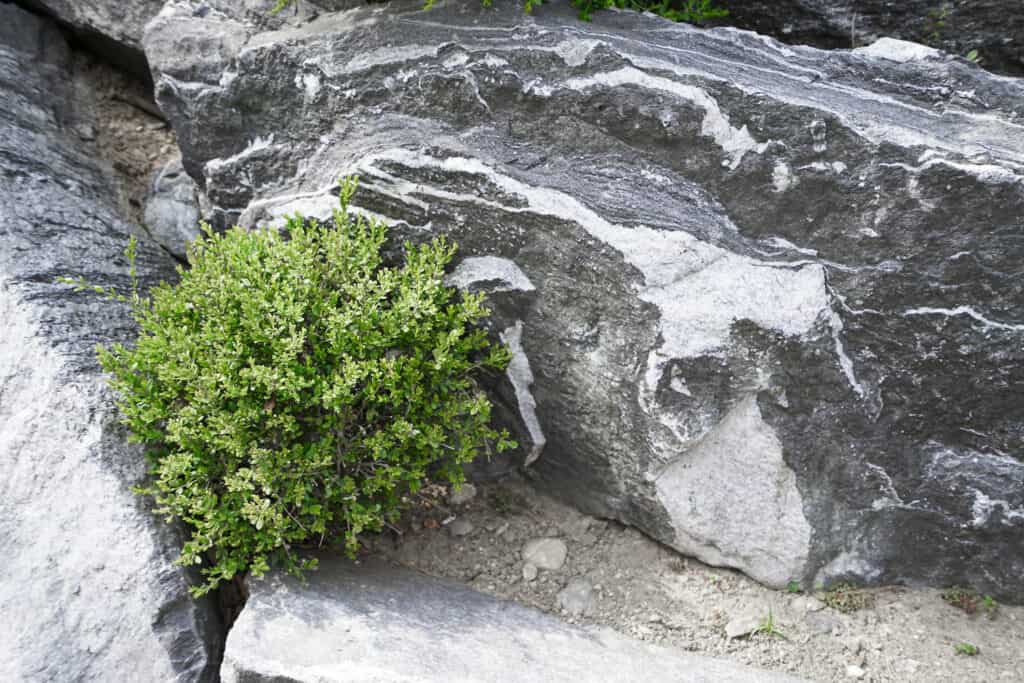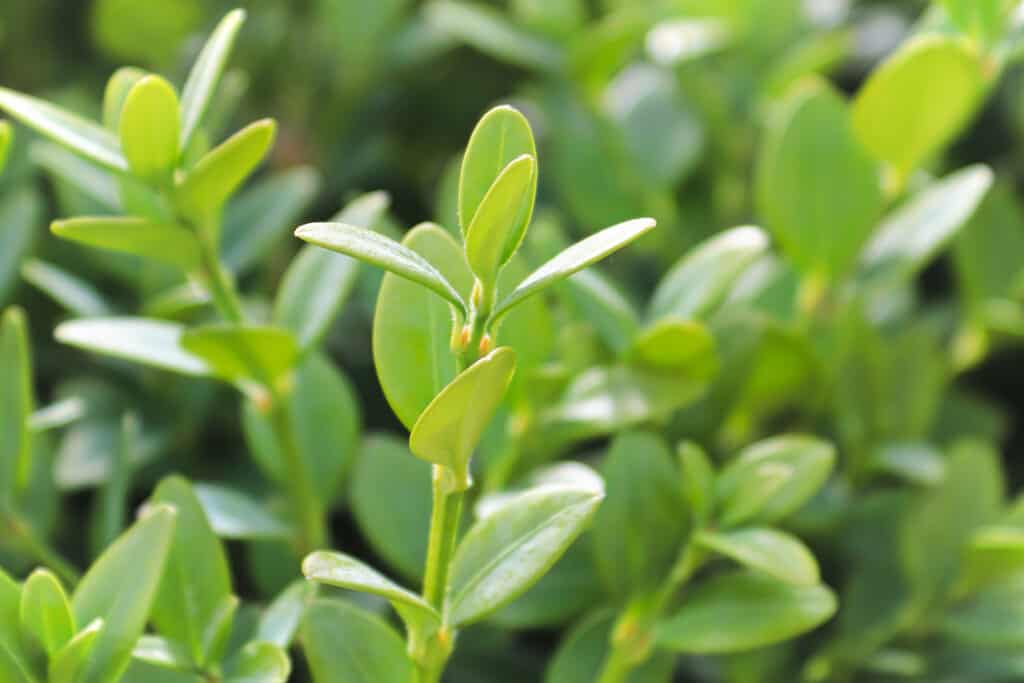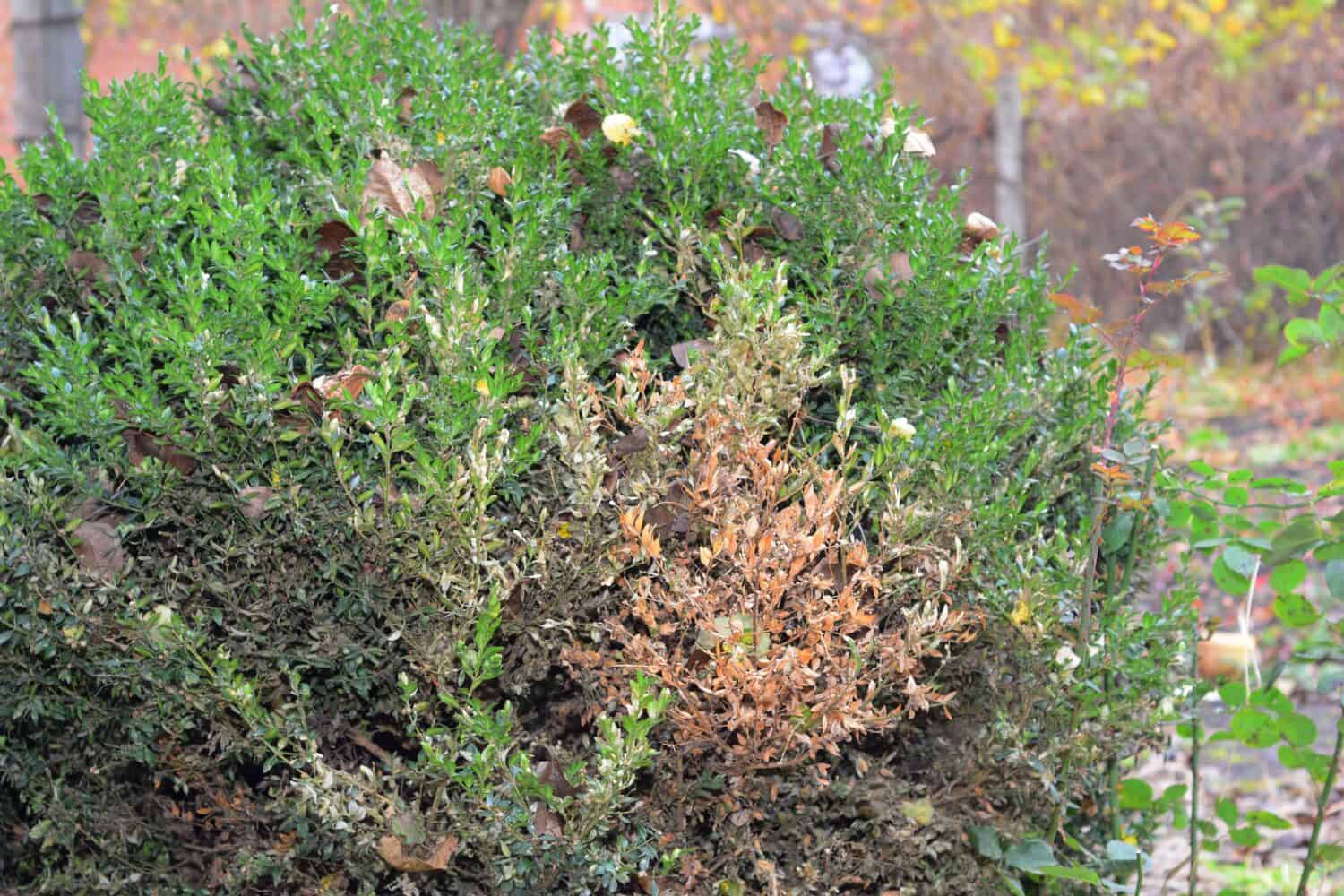If you’re planning a garden overhaul, consider these two Korean boxwoods: Wintergreen and/or Winter Gem. These are two really excellent boxwood plants that stay green all year round and smell deliciously sweet in spring. They love the shade, they’re hardy to minus 20 degrees F, and they bring year-round color. What’s not to love?
However, they look very similar. Let’s discover the differences between Wintergreen Boxwood vs. Winter Gem.
Main Differences Between Wintergreen and Winter Gem
Even though both species are Korean boxwoods, the key differences between Wintergreen and Winter Gem are their leaf color, cold tolerance, height/spread and sun tolerance. Winter Gem is the darker green of the two, and it prefers sun or partial sun. Wintergreen has lighter leaves and does better in shade. Wintergreen often grows taller and it’s a zone hardier too.
| Wintergreen | Winter Gem | |
|---|---|---|
| Name | Buxus sinica var. Insularis ‘Wintergreen’ | Buxus sinica var. insularis ‘Winter Gem’ |
| Foliage | Dark green with bright green new growth | Dark green with lime green new growth. Foliage a touch darker than Wintergreen |
| Flowers | Spring time, fragrant, yellow-green | Spring time, fragrant, yellow-green |
| Height and Spread | Around four feet by four feet. Slightly taller than wide | Around four feet by four feet. Slightly wider than tall |
| Sun Tolerance | Sun tolerant, prefer partial sun to shade | Sun tolerant, prefers partial shade or full sun |
| Growing Zones | 4-9 | 5-9 |
| Toxicity | Toxic to dogs, cats, and horses if chewed | Toxic to dogs, cats, and horses if chewed |
What Is Boxwood?
Boxwood belongs to the Buxaceae family of around 70 different species. The botanical name is Buxus, but it’s also called just box. It’s a slow-growing shrub or tree that can reach 15 feet with small evergreen leaves that are popular for topiary.
The buxus genera are native to a wide variety of areas including Europe, Asia, Africa, the Caribbean, South and Central America, Mexico, and Madagascar, but it’s cultivated across the world.
Historically boxwood was used in a variety of fields including musical instruments and precision tools. Before plastic was invented boxwood was one of the few kinds of wood that didn’t shrink, so it was a very popular material.
European boxwood was taken to America by early European settlers where it’s particularly popular in cold zones.

Boxwoods are hardy shrubs that can grow almost anywhere.
©iStock.com/Maria Usanina
Wintergreen vs. Winter Gem: Origins
Buxus Microphylla, which means boxwood little leaf, is native to China, Korea, and Japan where it has been cultivated for centuries, particularly as a topiary and bonsai. It grows well in the northeastern United States filling in the freezing gap that European boxwood can’t tolerate.
Wintergreen and Winter Gem are both selected Asian buxus microphylla varieties that withstand minus temperatures and heat.
What Can You Do With Boxwood?
Boxwood shrubs are versatile and great for a variety of landscaping needs such as pathway edging, herb garden dividers, hedges up to four feet, clipped topiary balls, cubes, spirals, or pyramids, and creating an evergreen backbone for your garden. Boxwoods are really great for providing a green background for your bright perennials and annuals.
Boxwoods such as Wintergreen and Winter Gem are also excellent for wildlife. They provide shelter for birds, insects, and small mammals like wild hedgehogs in freezing temperatures, but happily for us it’s rabbit and deer proof too!
Perhaps the best boxwood feature is that you can just leave it alone. It’ll grow in a densely rounded shape with evergreen foliage without any assistance. It’s the perfect choice for low-maintenance gardens and busy people who still want an attractive outside space.
Wintergreen vs. Winter Gem: Foliage
Winter Gem grows in a rounded shape with tiny microphylla leaves that are only three-quarters of an inch long. Its new growth emerges bright lime green and matures to deep glossy green. In winter it tends to turn a bronze shade in very cold areas, but this disappears when the warmth of spring arrives.
Wintergreen is very similar. It’s also a rounded shrub with tiny three-quarter-inch leaves that emerge bright green and mature to deep green. It may also turn bronze in the winter.
The more you clip Wintergreen and Winter Gem, the thicker and denser their foliage becomes.
Both shrubs have green foliage and are winter hardy, but Winter Gem is slightly darker in color and tends to grow wider than its height. Wintergreen is usually a little taller than it is wide.
When both are grown in sun, their foliage grows faster and lighter in tone, but in shade, they slow down and have a deeper green hue.

Boxwood leaves average around three-quarters of an inch.
©iStock.com/Akchamczuk
Do Wintergreen and Winter Gem Have Flowers?
Korean boxwoods like Wintergreen and Winter Gem have flowers, but they are small and insignificant, so if you don’t clip boxwood in early spring the flowers will arrive and surprise you with their sweet fragrance. Their tiny blooms emerge yellow-green in spring and it’s easy to miss them.
However, pollinators will not miss them! Boxwood flowers are excellent flowers for bees, butterflies, and other beneficial pollinators.
Do Boxwoods Stay Green All Year?
All types of boxwoods stay green over winter, including Wintergreen and Winter Gem varieties. In cold areas they may develop a bronze tinge, but this returns to green in spring. European boxwood is more likely to turn brown and develop dead patches overwintering in cold zones.

Boxwoods are quite hardy in cold climates.
©iStock.com/Herman Vlad
Boxwood Growing Zones
- Wintergreen Zones 4-9
- Winter Gem Zones 5-9
Korean boxwoods like Wintergreen and Winter Gem grow in sun or shade and are reliably frost-tolerant. Wintergreen and Winter Gem cope with temperatures that fall to minus 20 degrees F. There aren’t many species of plant that can achieve such a range, and this is why Korean boxwoods are so popular with landscapers. They are both top choices for colder areas, as they are hardier than European boxwoods, which grow in Zones 6-8.
How Tall Do Boxwoods Grow?
Both Wintergreen and Winter Gem boxwoods are slow-growing, maturing at approximately four feet in height. However, Wintergreen takes longer to get there. In ideal conditions, it’s slower growing at six inches a year, whereas Winter Gem can grow up to eight inches a year.
Are Boxwoods Toxic To Dogs?
Boxwood is toxic to dogs, cats, and horses according to the ASPCA because it contains toxic alkaloids. The symptoms in cats and dogs include vomiting and diarrhea, but horses may also experience colic, seizures and breathlessness.
It’s best to always clear away any clippings and ensure pets can’t chew on boxwood foliage, flowers or wood.
How To Grow Wintergreen vs. Winter Gem
It’s easy to grow Wintergreen and Winter Gem boxwoods because they thrive in a wide variety of conditions.
- Soil: Any soil that’s well drained
- Sun: Sun, shade, or partial sun.
- Fertilizer: Once in spring, either mulch or liquid feed
- Water: Lots of water after planting, but they’re drought tolerant in a normal summer
Take care cultivating the soil around boxwoods, because they are shallow-rooted and any disturbance can disrupt their roots leading to die-off and brown patches.
Are there any differences in growing the two species? Yes! There is one difference between the two: Winter Gem does better in partial shade or full sun, whereas Wintergreen prefers partial sun or shade.
Boxwoods growing in containers need extra assistance because their roots can’t access water or nutrients naturally. Pot-grown boxwoods need regular water and fertilizer in the hot months and bricks beneath the base in winter to help drain off excess rain.
How Do You Prune Boxwoods?
Prune boxwoods at any time of year, but avoid mid-to-late fall because new growth encouraged by pruning won’t have time to harden off.
Clip boxwoods with an electric hedge trimmer or hand shears, cutting away the new season’s growth to the height you want. The more you clip a boxwood, the denser its foliage grows, so it’s a good idea to clip at least twice when the shrubs are new. If you want flowers, avoid clipping boxwoods in early spring.
No particular technique is required.
Which Is Best Wintergreen or Winter Gem?
Both of these Korean boxwood varieties are excellent hedges, topiary, and wildlife shelters. Their evergreen foliage is dense, green all year-round, and they produce fragrant pollinator-friendly flowers. They are both a good choice in cold areas.
The differences are that Wintergreen is a zone hardier (zone 4), it has lighter leaves, and grows a little more slowly. However, Winter Gem is better in full sun and its foliage is darker.
Either way, you can’t go wrong.
Bonus: What is Boxwood Blight?

Mature plants can survive boxwood blight but will never look the same after pruning.
Image: Radovan1, Shutterstock
©Radovan1/Shutterstock.com
After reading this article you may be excited to purchase a Korean boxwood for your yard or garden. Before purchasing from your local nursery or plant store you may want to ask if they have noticed any plants with boxwood blight.
Boxwood blight is a fungal disease that is easily transported in the nursery industry and can be transmitted to plants that show no sign of infection at the time they are shipped. It can be brought to you on a new boxwood plant or even by sprigs of boxwood in fresh Christmas wreaths or greenery. This disease was first seen in the U.S. in 2011 and has now been reported in more than 20 states and three Canadian provinces.
Symptoms begin as dark leaf spots that enlarge to form big brown blotches. The undersides of the infected leaves will show white spores following a period of high humidity. The disease causes rapid deterioration beginning on lower branches and moving up. The disease does not attack roots and more established plants could survive cutting the diseased parts off – but the plant will never look the same. Boxwood blight can live in soil for years – fungicides applied to newly infected plants offer the only hope. The disease affects American, English, Japanese and Korean boxwoods.
The photo featured at the top of this post is © iStock.com/Yarygin
Sources
- The Tree Center, Available here: https://www.thetreecenter.com/wintergreen-boxwood/
- The Tree Center, Available here: https://www.thetreecenter.com/winter-gem-boxwood/
- Bellarmine, Available here: https://www.bellarmine.edu/faculty/drobinson/Boxwood.htm#:~:text=The%20Boxwood%20was%20first%20used,and%20widely%20used%20in%20landscaping.
Thank you for reading! Have some feedback for us? Contact the AZ Animals editorial team.






